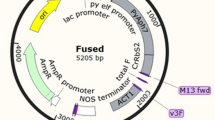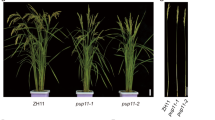Abstract
The essential amino acid lysine is synthesized in higher plants by a complex pathway that is predominantly regulated by feedback inhibition of two enzymes, namely aspartate kinase (AK) and dihydrodipicolinate synthase (DHPS). Although DHPS is thought to play a major role in this regulation, the relative importance of AK is not known. In order to study this regulation, we have expressed in the chloroplasts of transgenic potato plants a DHPS derived from Escherichia coli at a level 50-fold above the endogenous DHPS. The bacterial enzyme is much less sensitive to lysine inhibition than its potato counterpart. DHPS activity in leaves, roots and tubers of the transgenic plants was considerably higher and more resistant to lysine inhibition than in control untransformed plants. Furthermore, this activity was accompanied by a significant increase in level of free lysine in all three tissues. Yet, the extent of lysine overproduction in potato leaves was significantly lower than that previously reported in leaves of transgenic plants expressing the same bacterial enzyme, suggesting that in potato, AK may also play a major regulatory role in lysine biosynthesis. Indeed, the elevated level of free lysine in the transgenic potato plants was shown to inhibit the lysine-sensitive AK activity in vivo. Our results support previous reports showing that DHPS is the major rate-limiting enzyme for lysine synthesis in higher plants, but they suggest that additional plant-specific regulatory factors are also involved.
Similar content being viewed by others
References
Aarnes H, Rognes SE: Threonine-sensitive aspartate kinase and homoserine dehydrogenase from Pisum sativum. Phytochemistry 13: 2717–2724 (1974).
An G: Development of plant promoter expression vectors and their use for analysis of differential activity of nopaline synthase promoter in transformed tobacco cells. Plant Physiol 84: 86–91 (1986).
Arnon DI: Copper enzymes in isolated chloroplasts. Polyphenoloxidase in Beta vulgaris. Plant Physiol 24: 1–15 (1949).
Bagni N, Creus J, Pistocchi R: Distribution of cadaverine and lysine decarboxylase activity in Nicotiana glauca plants. J Plant Physiol 125: 9–15 (1986).
Bieleski RL, Turner NA: Separation and estimation of amino-acids in crude plant extracts by thin-layer electrophoresis and chromatography. Anal Biochem 17: 278–293 (1966).
Bright SWJ, Kueh JHS, Franklin J, Rognes SE, Miflin BJ: Two genes for threonine accumulation in barley seeds. Nature 299: 278–279 (1982).
Bright SWJ, Miflin BJ, Rognes SE: Threonine accumulation in seed of a barley mutant with an altered aspartate kinase. Biochem Genet 20: 229–243 (1982).
Bright WJ, Shewry PR: Improvement of protein quality in cereals. CRC Crit Rev Plant Sci 1: 49–93 (1983).
Bryan JK: Synthesis of the aspartate family and branched-chain amino acids. In: Miflin BJ (ed) The Biochemistry of Plants, vol. 5, pp. 403–452. Academic Press, New York (1980).
Burnette WN: ‘Western blotting’: Electrophoretic transfer of proteins from sodium dodecyl sulfate-polyacrylamide gels to unmodified nitrocellulose and radiographic detection with antibody and protein A. Anal Biochem 112: 195–203 (1981).
Cattoir-Reynaerts A, Degryse E, Verbruggen I: Isolation and characterization of a lysine + threonine resistant variant in Daucus carota. Biochem Physiol Pflanz 178: 81–90 (1983).
Davies DD: Factors affecting protein turnover in plants. In: Hewitt EJ, Cutting CV (eds) Nitrogen Assimilation of Plants, pp. 369–396. Academic Press, New York (1979).
Davies DD, Miflin BJ: Regulatory isoenzymes of aspartate kinase and the control of lysine and threonine biosynthesis in carrot cell suspension culture. Plant Physiol 62: 536–541 (1978).
Dotson SB, Frisch DA, Somers DA, Gengenbach BG: Lysine-insensitive aspartate kinase in two threonineoverproducing mutants of maize. Planta 182: 546–552 (1990).
Fluhr R, Moses P, Morelli G, Coruzzi G, Chua N-H: Expression dynamics of the pea rbcS family and organ distribution of the transcripts. EMBO J 5: 2063–2071 (1986).
Gallie SR, Lucas WJ, Walbot V: Visualizing mRNA expression in plant protoplasts: Factors influencing efficient mRNA uptake and translation. Plant Cell 1: 301–311 (1989).
Guilley H, Dudley RK, Jonard G, Balzas E, Richards KE: Transcription of Cauliflower mosaic virus DNA: detection of promoter sequences, and characterization of transcripts. Cell 30: 763–773 (1982).
Heinhorst S, Cannon GC, Galun E, Kenschaft L, Weissbach A: Clone bank and physical and genetic map of patato chloroplast DNA. Theor Appl Genet 75: 244–251 (1988).
Hibberd KA, Green CE: Inheritance and expression of lysine plus threonine resistance selected in maize tissue culture. Proc Natl Acad Sci USA 79: 559–563 (1982).
Hibberd KA, Walter T, Green CE, Gengenbach BG: Selection and characterization of feedback-insensitive tissue culture of maize. Planta 148: 183–187 (1980).
Hurst WJ: O-phthaldehyde derivative of amino acids in cocoa beans. In: Hancock WS (ed) CRC Handbook of HPLC for the Separation of Amino Acids, Peptides and Proteins, vol 1, pp. 325–330. CRC Press, Boca Raton, FL (1984).
Laemmli UK: Cleavage of structural proteins during the assembly of the head of bacteriophage T4. Nature 227: 680–685 (1970).
Lea PJ, Mills WR, Miflin BJ: The isolation of lysinesensitive aspartate kinase from pea leaves and its involvement in homoserine biosynthesis in isolated chloroplasts. FEBS Lett 98: 165–168 (1979).
Matthews BF, Widholm JM: Regulation of lysine and threonine synthesis in carrot cell suspension culture. Planta 141: 315–321 (1978).
Matthews BF, Widholm JM: Enzyme expression in soybean cotyledon, callus and cell suspension culture. Can J Bot 57: 299–304 (1979).
Murashige T, Skoog F: A revised medium for rapid growth and bioassays with tobacco tissue cultures. Physiol Plant 15: 473–497 (1962).
Negrutiu I, Cattoir-Reynearts A, Verbruggen I, Jacoos M: Lysine overproducer mutants with an altered dihydropicolinate synthase from protoplast culture of Nicotiana sylvestris (Spegazzini and Comes). Theor Appl Genet 68: 11–20 (1984).
Nitsch JP: Experimental androgenesis in Nicotiana. Phytomorphology 19: 389–404 (1969).
Odell JT, Nagy F, Chua N-H: Identification of DNA sequences required for activity of the cauliflower mosaic virus 35S promoter. Nature 313: 810–812 (1985).
Perl-Treves R, Abu-Abied M, Magal N, Galun E, Zamir D: Genetic mapping of tomato cDNA clones encoding the chloroplastic and cytosolic isozymes of superoxide dismutase. Biochem Genet 28: 543–552 (1992).
Richaud F, Richaud C, Rafet P, Patte JC: Chromosomal location and nucleotide sequence of the Escherichia coli dapA gene. J Bact 166: 297–300 (1986).
Rognes SE, Bright SWJ, Miflin BJ: Feedback-insensitive aspartate kinase isoenzymes in barley mutants resistant to lysine plus threonine. Planta 157: 32–38 (1983).
Roshal S, Schell J, Schmidt R, Willmitzer L: Isolation and characterization of a gene from Solanum tuberosum encoding patatin, the major storage protein in potato. Mol Gen Genet 203: 214–220 (1986).
Sanako K, Komamine A: Change in the proportion of two aspartokinases in carrot root tissue in response to in vitro culture. Plant Physiol 61: 115–118 (1978).
Shaul O, Galili G: Increased lysine synthesis in transgenic tobacco plants expressing a bacterial dihydrodipicolinate synthase in their chloroplasts. Plant J 2: 203–209 (1991).
Sheerman S, Bevan MW: A rapid transformation method for Solanum tuberosum using binary Agrobacterium tumefaciens vectors. Plant Cell Rep 7: 13–16 (1988).
Yugari Y, Gilvarg C: The condensation step in diaminopimelate synthesis. J Biol Chem 240: 4710–4716 (1965).
Author information
Authors and Affiliations
Rights and permissions
About this article
Cite this article
Perl, A., Shaul, O. & Galili, G. Regulation of lysine synthesis in transgenic potato plants expressing a bacterial dihydrodipicolinate synthase in their chloroplasts. Plant Mol Biol 19, 815–823 (1992). https://doi.org/10.1007/BF00027077
Received:
Accepted:
Issue Date:
DOI: https://doi.org/10.1007/BF00027077




